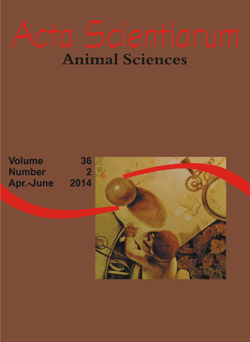<b>Diurnal ingestive behavior of Holstein calves reared in different systems: feedlot or pasture
Resumo
This study evaluated the ingestive behavior of Hostein calves kept in two husbandry systems: feedlot or pasture. We examined the ingestive behavior of 11 male non-castrated calves, with average initial age of 75 days, six of which were individually penned, consuming corn silage and concentrate-based diet at a ratio of 40:60 (on a DM basis), and the remainder, on pearl millet pasture (Pennisetum americanum) receiving concentrate supplementation at 1.0% body weight. Evaluations were held from November to February, from 8:00 am to 6:00 pm. Feedlot calves stay longer (p < 0.05) in idle, both in lying and standing positions, while animals on pasture spent more time in eating and ruminating activities. Confined animals performed a higher number of daily meals, but of shorter duration each. In both production systems, rumination activity is preferably performed in lying position, however, rumination time in standing position is about 1.4 times longer for those kept on pasture. Animals kept on pasture show a lower efficiency of DM intake, greater number of ruminated boluses, which were ruminated for less time and with fewer cud chewings.
Downloads
DECLARAÇÃO DE ORIGINALIDADE E DIREITOS AUTORAIS
Declaro que o presente artigo é original, não tendo sido submetido à publicação em qualquer outro periódico nacional ou internacional, quer seja em parte ou em sua totalidade.
Os direitos autorais pertencem exclusivamente aos autores. Os direitos de licenciamento utilizados pelo periódico é a licença Creative Commons Attribution 4.0 (CC BY 4.0): são permitidos o compartilhamento (cópia e distribuição do material em qualqer meio ou formato) e adaptação (remix, transformação e criação de material a partir do conteúdo assim licenciado para quaisquer fins, inclusive comerciais.
Recomenda-se a leitura desse link para maiores informações sobre o tema: fornecimento de créditos e referências de forma correta, entre outros detalhes cruciais para uso adequado do material licenciado.








































